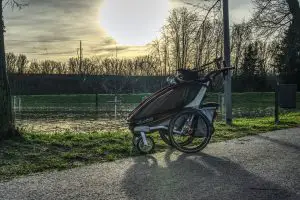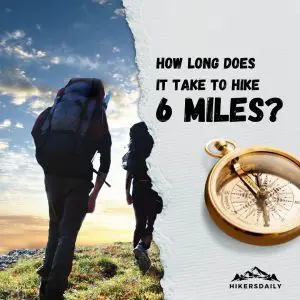Hiking With Spondylolisthesis (Safety Guide)

As someone who suffers from spondylosis and spondylolisthesis (and sciatica), I know all too well how debilitating these conditions can be. The constant sciatica and pain can make even the simplest of tasks seem impossible, let alone hiking. However, I refuse to let my conditions hold me back from the things I love, including hiking.
In this guide, I want to share my personal experience and tips for hiking with spondylolisthesis. I know firsthand how daunting it can seem to hit the trails with these conditions, but with the right preparation and techniques, it is possible to enjoy the great outdoors while managing your pain and discomfort. So, join me as we explore the benefits of hiking for people with spondylosis and spondylolisthesis and learn how to safely and successfully hit the trails with these conditions.
Quick Links
What Is Spondylolisthesis?
In a nutshell, spondylosis and spondylolisthesis are conditions that affect the spine, causing pain, discomfort, and limited mobility.
I’ll briefly talk about spondylosis first, because for me – it was the cause of spondylolisthesis. It’s a degenerative condition that affects the spinal discs, causing them to deteriorate over time. Spondylolisthesis is a condition in which a vertebra slips out of place, causing nerve compression, pain, and other symptoms. And again, according to The Advanced Spine Center (and my doctor), if you have Spondylosis, it can lead to spondylolisthesis over time.
Secondly, spondylolisthesis can cause compression of your nerves, which can lead to other problems such as sciatica. I wrote about my experience with sciatica and how I hike with it, you can read about my sciatica hiking safety guide here. Now, not everyone that has sciatica has spondylolisthesis, but in my case, it’s the spondy that is causing sciatica.
Now – I won’t get into too much of the specifics here, because if you’re reading this – you already know VERY well about both of these conditions – and just want some answers. If you’d like to read more, though, I’d suggest checking out this resource on spondylolisthesis from the Cleveland Clinic.
Common Issues with Hiking with Spondylolisthesis
Hiking with spondylolisthesis can be challenging due to the pain and discomfort associated with the condition. It is common to experience pain when standing or walking for extended periods of time (sometimes even after a few minutes – like I used to deal with), and to need frequent breaks. So how in the world are you supposed to go hiking, when all you do is stand and walk?
Well, there are some intermittent things you can do – until you see a doctor. I’ll get into the things that helped me first:
- Choose the right footwear. Proper shoes with good arch support and cushioning can help reduce the impact on your joints and provide better stability. You really can’t skimp out on cheap or poor-performing shoes, anymore. Sorry. You’ll need to invest here – it’s worth it.
- Trekking Poles. Additionally, using trekking poles can help reduce the pressure on your spine and provide additional support while hiking. I never wanted to use trekking poles when I was younger, well, because I thought they were useless (and for people with back issues.) Karma? Could be. But they help quite a bit.
- Back Brace: Wearing a solid back brace can do wonders for keeping your spine in a neutral position, and prevent it from unnecessary bending or stretching.
- Stretching: Stretching exercises can also help reduce pain and increase mobility. Before and after hiking, you should perform stretching exercises that focus on the lower back, hips, and legs. This can help loosen up tight muscles and improve flexibility – which can become a big issue with spondylolisthesis.
Now, again, you should be consulting with your doctor and physical therapist to find out what stretches work best for you. Everyone’s body and pain are unique, you shouldn’t try to figure this stuff out on your own. Not just that, but they’ll be able to suggest appropriate exercises or any modifications you might need to make for your hikes.
Tips for Hiking with Spondylolisthesis
Hiking can be a great way to enjoy staying active, even for individuals with spondylosis and spondylolisthesis. However, as I mentioned, it’s important to take certain precautions to ensure a safe and comfortable hiking experience. Here are some tips for hiking if you suffer from spondylolisthesis.
Choosing the right trail
When planning a hike, it is important to choose a trail that is appropriate for your level of fitness and ability. Look for trails that are well-maintained and have a gradual incline. Avoid trails with steep inclines or uneven terrain, as they can put extra stress on your spine and increase the risk of injury.
I know – it sounds like no more fun anymore. But the truth is, you can gradually work your way up. You don’t HAVE to be stuck with easy & flat trails forever. Just make sure to consult with your doctor, first.
Pacing yourself
It is VERY important to pace yourself when hiking with spondylosis or spondylolisthesis. Take frequent breaks to rest and stretch, and don’t push yourself too hard. Start with shorter hikes and gradually work up to longer distances as your fitness level improves.
Remember, you aren’t in a race. If you’re hiking with someone, let them know your condition – you’re gonna want to make sure you’re hiking with people that support and understand what you’re going through.
Proper posture and body alignment
Maintaining proper posture and body alignment while hiking can help reduce stress on your spine and prevent pain and discomfort. Keep your shoulders back and down, your chest lifted, and your core engaged. Take small, deliberate steps to maintain good balance and stability.
As I mentioned above, trekking poles and a back brace can do wonders for you here.
Listening to one’s body
Finally, it is essential to listen to your body when hiking with spondylosis or spondylolisthesis. If you feel pain or discomfort, take a break and stretch. Don’t push yourself too hard, and be willing to modify your hiking plans if needed.
Remember, it’s better to take things slow and steady than to risk injury or aggravating your issue and pain. In the next section, I’ll go over some specific techniques you can use to help with your hiking.
Hiking Techniques for People with Spondylolisthesis
So in this section, I wanted to go over some specific techniques you can use while hiking to help maintain a pain-free (or, as close to that) hike as possible.
- Use of trekking poles: I think this is the fourth time I’ve mentioned trekking poles here. Trekking poles can be a great tool for people with spondylosis and spondylolisthesis. They provide extra support and stability, particularly on uneven terrain or steep inclines. Hiking poles can also help reduce the impact on your spine, which can help prevent pain and discomfort.
- Gradual incline ascent and descent: When hiking with spondylolisthesis, it’s important to choose trails with gradual inclines rather than steep ones. This can help reduce stress on your spine and prevent pain and discomfort. When ascending or descending, take it slow and steady and try to maintain good posture and body alignment.
- Shorter strides and quicker steps: Taking shorter strides and quicker steps can help reduce the impact on your spine and prevent pain and discomfort. This technique can also help you maintain good balance and stability while hiking. This is something that helps me quite a bit.
- Proper backpack placement: Carrying a backpack while hiking can be challenging for people with spondylosis and spondylolisthesis. To help reduce stress on your spine, make sure your backpack is properly placed and adjusted. The backpack should be snug against your back and the weight should be evenly distributed.
Coping with Pain and Discomfort During Hiking
No matter what, you’ll probably still be experiencing some pain and discomfort – even if it’s much less than before. If you are doing everything in your power to fight the pain, taking doctors’ orders, and nothing seems to work – I get it.
I know it can be debilitating at times. But you can get through it. So I wanted to share some quick (non-hiking) things that I do to cope with the pain, that may also help you.
Breathing exercises
Deep breathing exercises can help reduce stress and tension in your body, which can help relieve pain and discomfort during hiking. Take slow, deep breaths in through your nose and out through your mouth. Focus on relaxing your body with each breath.
Mindfulness techniques
Mindfulness involves focusing your attention on the present moment and accepting your thoughts and feelings without judgment. Practicing mindfulness during hiking can help you stay present and engaged in the activity, rather than focusing on pain or discomfort.
Try focusing on the sights, sounds, and smells around you, and notice how your body feels as you move. And you don’t have to be spiritual, or religious to be mindful. Being mindful is all about being present.
Use of pain relief medication or topical ointments
The key to reducing the pain here is reducing inflammation. If you can take over-the-counter medication, and your doctor approved it, don’t be afraid to take it. They can really help.
This includes corticosteroids, such as methylprednisolone (which REALLY helps me). The only problem with steroids is that they can have potentially serious long-term side effects, so again, please consult with your doctor if you hike frequently.
Proper rest and recovery breaks
Taking proper rest and recovery breaks during hiking can help prevent pain and discomfort. Plan your hiking route with rest stops in mind, and take breaks as needed. During breaks, stretch your muscles and hydrate with water to help prevent muscle fatigue and cramping.
Conclusion
In conclusion, hiking can be a great way for people with spondylosis or spondylolisthesis to stay active and enjoy the outdoors – but it WILL take some getting used to.
While it’s important to take safety precautions, don’t let your condition stop you from trying hiking. With proper preparation and techniques, such as breaks AS needed, a back brace, or using trekking poles, hiking can be a rewarding and enjoyable activity for people with spondylolisthesis.
Lastly, again, I am not a medical professional – I am speaking purely from my own experiences, and I understand that each individual dealing with this pain can and will have their own methods that work for them. If all else fails, please seek professional advice as I did so you can get back on your feet, and hopefully be pain-free.






